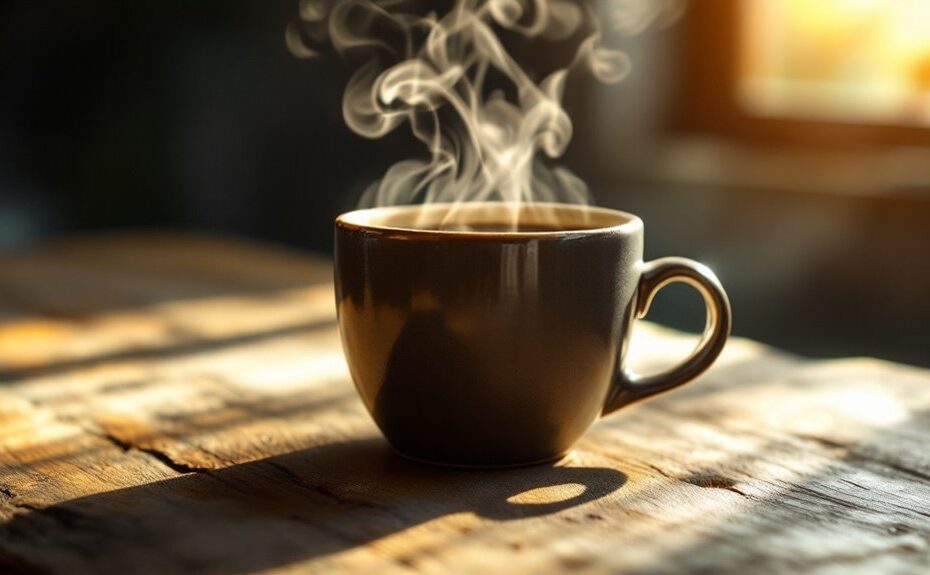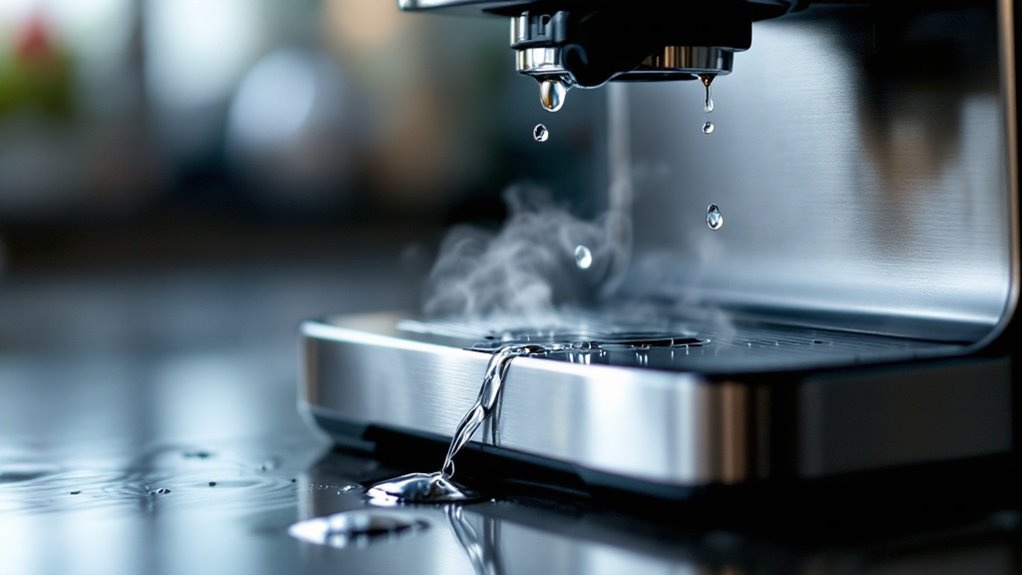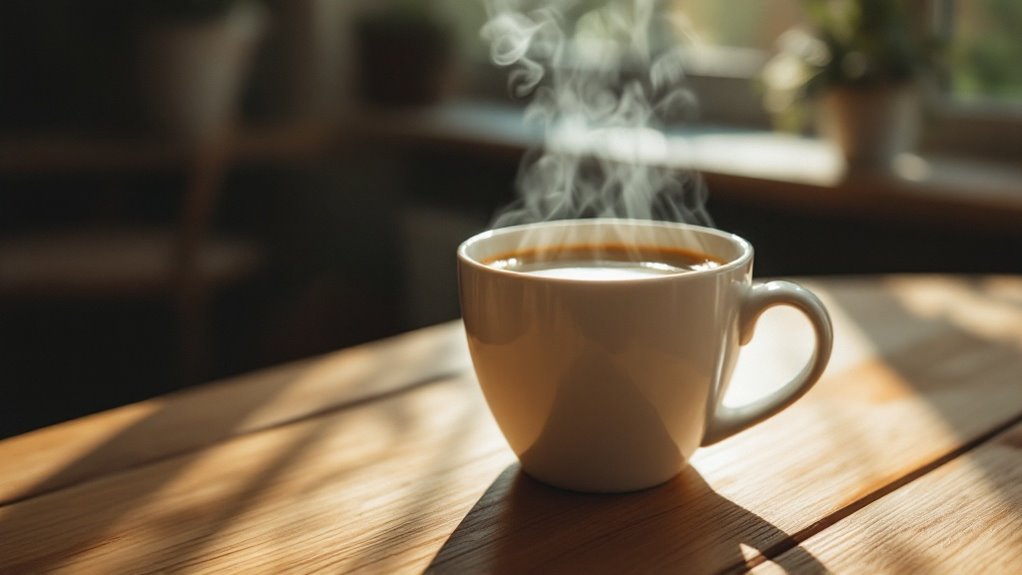







You might wonder why your coffee feels scalding even after a few minutes. It's likely because your brewing temperature exceeds the ideal range of 195°F–205°F, or your serving temperature is too high, masking the flavors and risking burns. Preheating your mug too much or using a warming tray could also be the culprit. But what if the heat isn't just about comfort—what if it's altering the taste and safety of your drink? There's more to uncover about how temperature impacts your coffee experience, and the solutions might surprise you.
Key Takeaways
- Brewing water above 205°F scalds coffee grounds, causing over-extraction and excessively hot coffee.
- Serving coffee above 140°F risks burns and masks delicate flavors, making it too hot to drink.
- Preheating mugs excessively or using warming trays can overheat coffee beyond the ideal serving temperature.
- Failing to let coffee cool for 3–5 minutes after brewing results in a beverage that is too hot.
- Equipment malfunctions or incorrect settings may cause coffee to be brewed or served at unsafe temperatures.
Ideal Brewing Temperature for Coffee
To brew the perfect cup of coffee, you'll want to nail the ideal temperature range—between 195°F and 205°F. This brewing temperature guarantees the best possible extraction of flavors from your coffee grounds, balancing acidity, sweetness, and bitterness. If your water temperature falls below 195°F, you risk under-extraction, leaving your brewed coffee weak, sour, and lacking depth. On the other hand, water hotter than 205°F can over-extract the grounds, resulting in a bitter, burnt taste that masks the coffee's natural nuances.
Specialty coffee shops often aim for a water temperature of 200°F, as it consistently delivers a balanced and flavorful cup. To achieve this perfect temperature at home, use a temperature-controlled kettle or let freshly boiled water cool for about 30 seconds before pouring it over your coffee grounds. Precision matters—too hot, and you'll scorch the grounds; too cool, and you'll miss out on the full spectrum of flavors. By mastering the ideal brewing temperature, you'll elevate your coffee experience, guaranteeing every sip is rich, aromatic, and satisfying.
Serving Temperature vs. Drinking Temperature
Your coffee is typically served at 180°F–185°F (82°C–85°C) to preserve its freshness, but this temperature is too high for immediate consumption. The ideal drinking range falls between 120°F and 140°F (49°C–60°C), where flavors are most pronounced and the risk of burns is minimized. Letting your coffee cool for 3–5 minutes or using preheated mugs can help you achieve this balance without sacrificing warmth.
Optimal Serving Heat Levels
The temperature at which coffee is served plays a critical role in both safety and flavor. To achieve the perfect balance, your coffee temperature should be hot enough to enhance its aroma and taste but not so hot that it scalds your tongue or masks subtle flavor notes. The ideal coffee serving temperature ranges between 140°F and 160°F (60°C to 71°C). This range guarantees the brew temperature preserves the coffee's complexity while allowing it to cool to a comfortable drinking temperature within minutes. If served above 160°F (71°C), your coffee will be too hot to drink immediately and can cause burns, especially if it exceeds 185°F (85°C). By the time your coffee reaches 120°F to 140°F (49°C to 60°C), it's at its ideal drinking temperature, where flavors are most pronounced and enjoyable. Serving within these ideal temperatures guarantees you experience the full spectrum of your coffee's profile without compromising safety or comfort. Always let your coffee cool slightly before sipping to avoid burning your mouth and to savor its true character.
Ideal Drinking Temperature Range
A steaming cup of coffee fresh from the brewer might seem inviting, but it's not ready to drink just yet. The temperature for coffee during brewing typically ranges from 195°F to 205°F (90°C to 96°C), but this hotter water isn't ideal for immediate consumption. Instead, you'll want your coffee to cool to an ideal serving temperature of 140°F to 160°F (60°C to 71°C) for the best balance of flavor and safety. At higher temperatures, you risk scalding your tongue and masking the nuanced flavors of your brew. Conversely, lower temperatures below 120°F (49°C) can dull the aromatic complexity and make your coffee taste flat. For the perfect temperature, aim for 120°F to 140°F (49°C to 60°C), where sweetness peaks at 111°F (44°C) and bitterness is least noticeable at 107°F (42°C). The FDA recommends serving hot beverages below 140°F (60°C) to prevent burns, ensuring a safer and more enjoyable experience. By understanding how different temperatures affect your coffee's flavor and safety, you can optimize your drinking experience without compromising quality.
How Temperature Affects Coffee Flavor
When brewing coffee, temperature plays a critical role in shaping its flavor profile. If your water is too hot—above 205°F—it over-extracts compounds, leading to bitterness and masking the coffee's natural sweetness and acidity. Conversely, brewing within the ideal range of 195°F to 205°F guarantees balanced extraction, highlighting the coffee's aromatic complexity and nuanced flavors.
Serving temperature also impacts how you perceive flavor. Drinking coffee above 150°F dulls your taste buds, making it harder to detect subtle notes of sweetness, acidity, or aromatic depth. A slightly cooler range of 120°F to 140°F allows these flavors to shine, enhancing the coffee's natural characteristics. However, if your coffee cools below 120°F, it may lose some aromatic intensity while emphasizing sweetness and acidity.
Overheating coffee during brewing or serving can release bitter tannins and burnt flavors, diminishing its overall quality. By controlling temperature at every stage, you secure your coffee delivers a harmonious balance of sweetness, acidity, and aromatic richness, tailored to your preferences.
Common Mistakes With Coffee Temperature
You might be overheating your brewing water, which scalds the grounds and creates a bitter taste, or ignoring the ideal serving range of 160°F (71°C), masking delicate flavors and risking burns. Serving coffee too hot often stems from preheating mugs excessively or relying on warming trays that overheat the brew. These mistakes not only compromise flavor but also make your coffee less enjoyable to drink.
Overheating Brewing Water
Overheating brewing water is a common pitfall that can ruin your coffee's flavor profile. When you pour hot water that's too close to boiling (212°F) directly onto your grounds, it scalds them, extracting bitter compounds like tannins and degrading delicate aromatic oils. This results in a harsh, burnt taste that overpowers the nuanced flavors of your drink. To brew a balanced hot cup, you must measure the temperature of your water carefully. The ideal temperature range for brewing is between 195°F and 205°F. If you're using boiling water, let it cool for about 30 seconds before pouring it over your coffee. This guarantees the water is hot enough to extract the right flavors without over-extracting or damaging the coffee oils. Overheating also accelerates the breakdown of these oils, robbing your brew of its smoothness and richness. By staying within the best temperature range, you'll preserve the complexity and aroma of your coffee, guaranteeing a satisfying drink every time. Always measure the temperature to avoid turning your hot coffee into a bitter disappointment.
Ignoring Optimal Serving Range
Ignoring the ideal serving range for coffee can lead to a disappointing experience, masking the drink's nuanced flavors and risking discomfort or injury. When you drink coffee that's too hot—above 155°F (68°C)—your taste buds struggle to detect subtle notes, and you risk burns. Conversely, if your cup cools below 120°F (49°C), you'll notice enhanced sweetness and acidity, but the aromatic complexity may diminish. The best temperatures to enjoy coffee range between 120°F and 140°F (49°C–60°C), where flavors balance perfectly and drinking becomes comfortable.
Different brewing methods and serving styles require attention to temperature. Preheating your cup or using an insulated container helps maintain the ideal range of 140°F–160°F (60°C–71°C) without overheating. Avoid serving coffee at 180°F (82°C) or higher, as it can cause severe burns in seconds. To truly enjoy coffee, let it cool slightly before drinking, allowing the flavors to shine without compromising safety. By respecting the most favorable serving range, you'll elevate your coffee experience, ensuring every sip is both enjoyable and flavorful.
Safety Concerns With Overly Hot Coffee
Served at temperatures exceeding 140°F (60°C), coffee can cause severe burns in mere seconds, highlighting a critical safety concern for consumers and businesses alike. When hot beverages like coffee are served above this threshold, they can inflict third-degree burns in just 2–7 seconds, leading to painful injuries and potential lawsuits. Over 700 injury reports were filed against McDonald's in the 1990s due to coffee served at 180–190°F (82–88°C), prompting significant policy changes and the adoption of warning labels to mitigate liability. Beyond immediate burns, regularly consuming coffee above 155°F (68°C) increases the risk of esophageal damage, which has been linked to esophageal cancer. To protect consumers, the FDA recommends serving hot beverages below 140°F, a guideline many businesses now follow to avoid legal and health risks. Warning labels on cups and lids have become standard practice, but ensuring coffee is served at safe temperatures remains the most effective way to prevent injuries. By prioritizing safety, businesses can reduce liability while safeguarding their customers from preventable harm.
Tips to Cool Down Hot Coffee Quickly
Several effective methods can help you cool down hot coffee quickly without compromising its flavor. Start by removing the lid from your cup of coffee to expose it to a larger surface area, allowing heat to dissipate faster through evaporation. For even quicker results, pour the Coffee Hot liquid into a shallow dish or transfer it between two cups to maximize heat exchange. If you prefer to keep your coffee intact, add a splash of cold milk or cream, which not only lowers the temperature but also enhances the flavor. Alternatively, use coffee ice cubes to cool your coffee without diluting it as they melt. Stirring your coffee with a metal spoon can also help transfer heat away from the liquid, speeding up the cooling process. Once your coffee has cooled to the desired temperature, you can enjoy it immediately. These techniques guarantee you can cool coffee efficiently while maintaining its rich taste and aroma.
Disclosure: As an Amazon Associate, I earn from qualifying purchases.






